The relationship between Corporate Governance and Cost of capital for Thai Listed Companies
Main Article Content
Abstract
The purpose of this research is to study the relationship between corporate governance and cost of capital for Thai listed companies. Samples used in this study were 300 Thai listed companies. Data collections were carried out by using the 2013 financial statements and annual reports from SETSMART database and company profiles. Multiple regression analysis was used for analyzing the relationship between corporate governance and cost of capital. The corporate governance was accessed by the responsibilities of the board aspect which can be divided into five topics regarding number of board meetings, proportion of independent director, percentage of shares holding for the boards, remuneration for the board and role duality of the chairman. The cost of capital was defined by gross borrowing cost, dividend payout ratio, cash flow from operation ratio and current ratio. The results found that cost of capital in terms of gross borrowing cost and dividend payout ratio are significantly negative to the corporate governance whereas cash flow from operation ratio and current ratio were not related to the corporate governance at significance level (P<0.05).
Article Details
Views and opinions appearing in the Journal it is the responsibility of the author of the article, and does not constitute the view and responsibility of the editorial team.
References
Agrawal, A., & Chadha, S. (2005). Corporate governance and accounting scandals. The Journal of Law and Economics, 48(2), 371-406.
Beiner, S., Drobetz, W., Schmid, F., & Zimmermann, H. (2004). Is board size an independent corporate governance mechanism?. Kyklos, 57(3), 327-356.
Black, B. S., & Khanna, V. S. (2007). Can corporate governance reforms increase firm market values? Event study evidence from India. Journal of Empirical Legal Studies, 4(4), 749-796.
Botosan, C. A., Plumlee, M. A., & Xie, Y. (2004). The role of information precision in determining the cost of equity capital. Review of Accounting Studies, 9(2), 233-259.
Connelly, J. T., Limpaphayom, P., & Nagarajan, N. J. (2012). Form versus substance: The effect of ownership structure and corporate governance on firm value in Thailand. Journal of Banking & Finance, \36(6), 1722-1743.
Dehipegedara, B. (2015). Corporate governance and company performance. Proceedings of the Undergraduates Research Conference, Department of Accountancy, University of Kelaniya, Sri Lanka.
Doupnik, T. and Perera, H. (2015). International Accounting. (4th ed.). Boston:McGraw-Hill.
Elena, G. C. (2012). Theoretical framework for corporate governance. Ovidius University Annals, Economic Sciences Series, 12(1), 493-498.
Gruszcynski, L. (2006). Science in the process of risk regulation under the WTO agreement on sanitary and phytosanitary measures. German LJ, 7, 371.
Heath, J., & Norman, W. (2004). Stakeholder theory, corporate governance and public management: what can the history of state-run enterprises teach us in the post-Enron era?. Journal of business ethics, 53(3), 247-265.
Hill, C. W., & Jones, T. M. (1992). Stakeholder‐agency theory. Journal of management studies, 29(2), 131-154.
Ho, S. S., & Wong, K. S. (2001). A study of the relationship between corporate governance structures and the extent of voluntary disclosure. Journal of International Accounting, Auditing and Taxation, 10(2), 139-156.
IOD. (2016). Corporate Governance Report of Thai Listed Companies 2016. from http://www.thai-iod.com/en/publications-detail.asp?id=310&type=4.
Jensen, M. (2001). Value maximisation, stakeholder theory, and the corporate objective function. European financial management, 7(3), 297-317.
Jensen, M.C. and Meckling, W.H. (1976). Theory of the firm: Managerial behavior, agency costs and ownership structure. Journal of Financial Economics, 3, 305-360.
Kaseamsap W. (2010). Corporate Governance and Firm Performance. Thammasat University. Faculty of Commerce and Accountancy.
Krejcie, R. V., & Morgan, D. W. (1970). Determining sample size for research activities. Educational and psychological measurement, 30(3), 607-610.
Kyereboah‐Coleman, A. (2007). Corporate governance and shareholder value maximization: An African perspective. African Development Review, 19(2), 350-367.
Limpaphayom, P., & Connelly, J. T. (2004). Corporate governance in Thailand.
Ohlson, J. A. (1995). Earnings, book values, and dividends in equity valuation. Contemporary Accounting research, 11(2), 661-687.
Poramapojn P. (2014) Determinants of the Probability of Good Corporate Governance: Evidence from Thailand. Chulalongkorn Business Review, 36 (141), 55-72.
SET. (2012). The Principles of Good Corporate Governance for Listed Companies 2012. from https://www.set.or.th/sustainable_dev/th/cg/files/2013/CGPrinciple2012Thai-Eng.pdf
Srijunpetch S. (2008). Corporate Governance. Journal of Business Administration, 31 (120), 1-4.
Sukanantasak, N. (2014). The effect of corporate governance mechanisms on earnings informativeness through earnings persistence: Empirical evidence from Thailand. Journal of Accounting Profession, 10(27), 14-31.
Tian, L. (2005). Bank lending, corporate governance and government ownership in China.Guanghua School of Management, Beijing University.
Tricker, R. B., & Tricker, R. I. (2015). Corporate governance: Principles, policies, and practices. Oxford University Press, USA.


